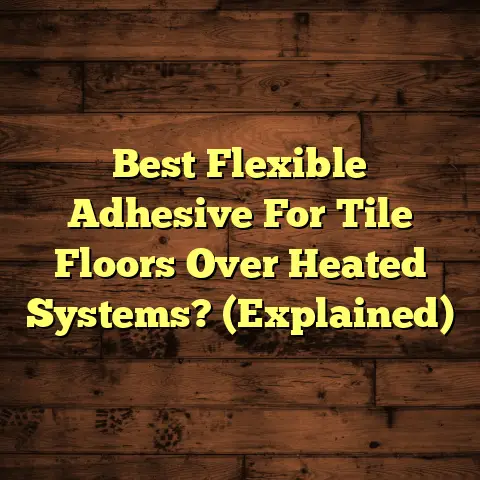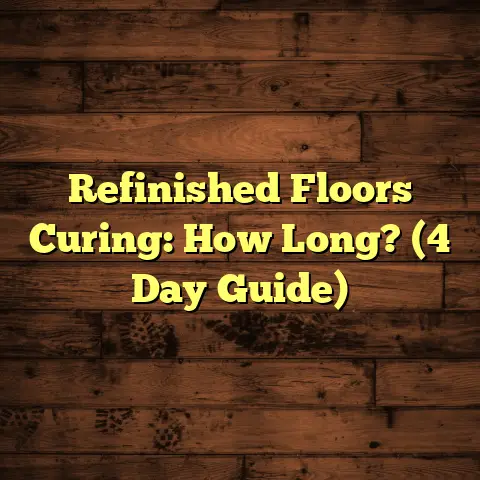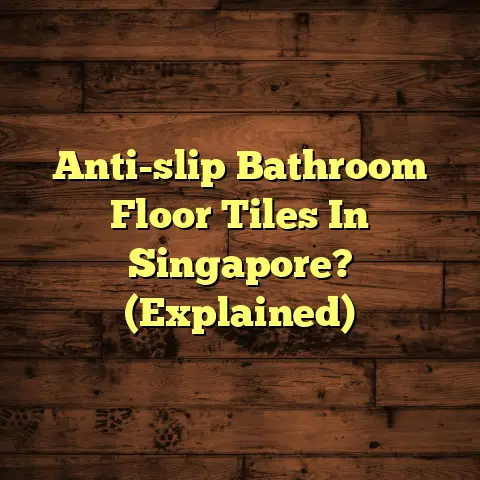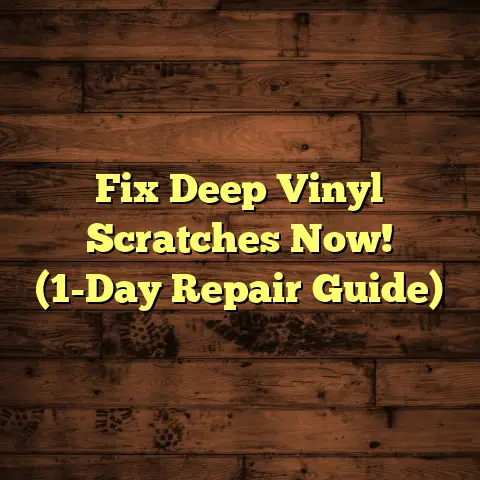Clean Concrete After Carpet? (8 Mistake Fixes!)
Introduction:
Riding the Concrete Wave
Lately, everyone’s going nuts for concrete! It’s durable, looks awesome, and you can do so much with it. Plus, it’s way more eco-friendly than chucking out old flooring and buying new.
But let’s be real, carpet’s comfy! Especially in bedrooms or living rooms where you want that cozy vibe. The problem? What happens when you decide to ditch the carpet and go back to the concrete underneath?
More and more homeowners are becoming DIY warriors, tackling projects themselves. That’s fantastic! But cleaning concrete after carpet removal? It can be trickier than it looks. Trust me, I’ve seen some serious DIY fails!
The Big Question:
So, how do you get that concrete floor looking amazing after pulling up carpet? That’s what we’re diving into today.
I’m going to walk you through eight common mistakes I see people make and, more importantly, how to fix them. Get ready to transform that hidden concrete into a showstopper!
Body:
Section 1: Understanding the Concrete Floor
Underneath Carpet
Okay, let’s talk reality. What’s usually hiding under that carpet?
-
Stains: Years of spills, pet accidents, and who-knows-what-else can leave their mark.
-
Adhesive Residue: That sticky stuff is stubborn.
-
Surface Imperfections: Cracks, chips, uneven spots – they’re all common.
Before you even think about cleaning, you need to assess the situation. What are you dealing with?
Section 2: Mistake #1 – Skipping the
Pre-Cleaning Assessment
Seriously, don’t skip this! It’s like going into battle without knowing the terrain.
I always tell my clients: “Inspect, inspect, inspect!”
What are you looking for?
- Cracks: Are they hairline cracks or something deeper?
- Stains: What caused the stain? This will help you choose the right cleaner.
- Adhesive Type: Some adhesives are water-based, others are solvent-based. Knowing this is key!
- Overall Condition: Is the concrete spalling (flaking)? Is it really rough?
How to Inspect:
- Get Down Low: Use a flashlight and get on your hands and knees. You’ll see way more this way!
- Feel the Surface: Run your hand over the concrete. Are there any rough spots? Sticky areas?
- Take Photos: Document everything! This will help you track your progress and remember what you’ve tried.
Pro Tip: Try a small test area with your chosen cleaner before you go all-out. You don’t want to make things worse!
Section 3: Mistake #2 – Using the Wrong
Cleaning Products
This is a big one! I’ve seen people ruin perfectly good concrete by using the wrong stuff.
What to Avoid:
- Acidic Cleaners: Muriatic acid, for example, can etch and damage concrete. Unless you really know what you’re doing, stay away!
- Abrasive Cleaners: Steel wool or harsh scrubbing powders can scratch the surface.
- Bleach: While it might seem like a good idea for stains, bleach can discolor concrete and damage sealants.
Safe and Effective Alternatives:
- pH-Neutral Cleaners: These are your best bet for general cleaning. Look for products specifically designed for concrete.
- Enzyme Cleaners: Great for pet stains! The enzymes break down the organic matter.
- Citrus Cleaners: Natural and effective for degreasing.
Eco-Friendly Options:
- Baking Soda: A mild abrasive that can help with stains.
- Vinegar: Diluted vinegar can be used for general cleaning. Always test in an inconspicuous area first!
- Castile Soap: A gentle, plant-based soap that’s safe for concrete.
My Go-To: I often use a simple solution of water and dish soap for general cleaning. It’s effective and won’t damage the concrete.
Section 4: Mistake #3 – Failing to Remove
Adhesive Residue Properly
Ah, the dreaded adhesive! This is probably the biggest pain when cleaning concrete after carpet.
Why is it a problem?
- It’s Sticky! Obvious, right? But that stickiness attracts dirt and grime.
- It Can Discolor: Over time, adhesive can yellow or darken, making your concrete look uneven.
- It Prevents Sealing: You can’t properly seal concrete with adhesive residue on it.
Step-by-Step Adhesive Removal:
- Scrape: Use a plastic scraper to remove as much of the adhesive as possible. A metal scraper can be used, but be extremely careful not to scratch the concrete.
- Solvent Time: Choose the right solvent
based on the adhesive type.
- Water-Based Adhesives: Try hot water and dish soap first. If that doesn’t work, move on to a stronger solvent.
- Solvent-Based Adhesives: Mineral spirits, acetone, or adhesive removers specifically designed for concrete. Always follow the manufacturer’s instructions!
- Apply the Solvent: Soak a rag or sponge with the solvent and apply it to the adhesive. Let it sit for 15-30 minutes to soften the adhesive.
- Scrub: Use a scrub brush or a nylon scrub pad to scrub the adhesive.
- Wipe Clean: Wipe away the loosened adhesive with a clean rag.
- Repeat: You’ll probably need to repeat steps 3-5 several times to remove all the adhesive.
- Rinse: Once you’ve removed the adhesive, rinse the concrete with clean water.
Important Safety Note: When working with solvents, always wear gloves and eye protection. Make sure you have good ventilation!
Personal Story: I once spent an entire day removing adhesive from a huge basement floor. It was exhausting, but the results were worth it! The key is patience.
Section 5: Mistake #4 – Ignoring Surface Stains
Stains are inevitable, especially after years of carpet covering them up.
Common Culprits:
- Pet Stains: Urine, vomit, etc.
- Water Marks: From leaks or spills.
- Rust Stains: From metal furniture or appliances.
- Oil Stains: From cars or machinery (if it’s a garage floor).
- Food and Drink Stains: Coffee, wine, etc.
Treatment Methods:
- Pet Stains:
- Enzyme Cleaner: As mentioned before, these are your best friend.
- Baking Soda Paste: Mix baking soda with water to form a paste. Apply to the stain, let it dry, and then scrub.
- Water Marks:
- Vinegar Solution: Mix equal parts vinegar and water. Apply to the stain, let it sit for a few minutes, and then scrub.
- Rust Stains:
- Lemon Juice and Salt: Apply lemon juice to the stain, sprinkle with salt, let it sit for a few hours, and then scrub.
- Commercial Rust Remover: Follow the manufacturer’s instructions carefully.
- Oil Stains:
- Kitty Litter: Pour kitty litter over the stain, let it sit overnight to absorb the oil, and then sweep it up.
- Degreaser: Apply a degreaser specifically designed for concrete.
- Food and Drink Stains:
- Baking Soda Paste: Works well for many food and drink stains.
- Hydrogen Peroxide: For tougher stains, try applying hydrogen peroxide. Always test in an inconspicuous area first!
Homemade Stain Remover Recipe:
- 1/2 cup baking soda
- 1/4 cup hydrogen peroxide
- 1 tablespoon dish soap
Mix into a paste, apply to the stain, let it sit for 30 minutes, and then scrub.
Important Note: Some stains are just too deep to remove completely. In these cases, you might need to consider staining or painting the concrete.
Section 6: Mistake #5 – Not Considering
Moisture Issues
Moisture can be a real enemy of concrete.
Why is it important?
- Mold and Mildew: Moisture can promote the growth of mold and mildew, which can cause health problems.
- Efflorescence: Moisture can cause efflorescence, a white, powdery substance that appears on the surface of the concrete.
- Damage to Sealants: Moisture can damage sealants, making them less effective.
How to Address Moisture Issues:
- Identify the Source: Where is the moisture coming from? Is it a leaky pipe? A high water table?
- Fix the Leak: Obviously, if there’s a leak, you need to fix it!
- Improve Ventilation: Increase ventilation in the area to help dry out the concrete.
- Use a Dehumidifier: A dehumidifier can help to remove moisture from the air.
- Apply a Moisture Barrier: If the moisture is coming from the ground, you might need to apply a moisture barrier to the concrete.
Testing for Moisture:
You can buy moisture meters that will tell you the moisture content of the concrete. A reading of above 4% is generally considered too high.
My Experience: I once worked on a basement floor that had a serious moisture problem. We had to install a French drain and apply a moisture barrier before we could even think about cleaning the concrete.
Section 7: Mistake #6 – Over-scrubbing the
Concrete Surface
I know, I know, you’re eager to get that concrete clean! But hold on a second. Over-scrubbing can actually damage the surface.
What can happen?
- Scratching: Abrasive scrub pads or brushes can scratch the concrete.
- Removing the Finish: If the concrete has a finish or sealant, over-scrubbing can remove it.
- Damaging the Aggregate: In some cases, over-scrubbing can damage the aggregate (the rocks and pebbles in the concrete).
Gentle Cleaning Techniques:
- Use a Soft Brush: A nylon scrub brush is a good choice.
- Apply Gentle Pressure: Let the cleaner do the work. Don’t scrub too hard!
- Work in Small Sections: Focus on one small area at a time.
- Rinse Frequently: Rinse the concrete frequently to remove dirt and debris.
Alternative Cleaning Tools:
- Microfiber Mop: Great for general cleaning.
- Steam Cleaner: Can be effective for removing dirt and grime.
- Pressure Washer: Only use a pressure washer on concrete that is in good condition. Use a low-pressure setting and a wide nozzle.
Remember: Patience is key! It’s better to take your time and clean the concrete gently than to rush and damage it.
Section 8: Mistake #7 – Neglecting to Seal
the Concrete After Cleaning
Sealing concrete is like putting a protective coat on it. It helps to prevent stains, moisture damage, and wear and tear.
Why is it important?
- Protection: Sealants protect the concrete from stains, moisture, and other damage.
- Durability: Sealants can help to extend the lifespan of the concrete.
- Appearance: Sealants can enhance the appearance of the concrete, giving it a glossy or matte finish.
Types of Sealants:
- Acrylic Sealants: Affordable and easy to apply, but not as durable as other types of sealants.
- Epoxy Sealants: Very durable and resistant to chemicals, but can be more expensive.
- Polyurethane Sealants: Durable and flexible, making them a good choice for areas that are subject to movement.
- Penetrating Sealants: These sealants penetrate the concrete, providing protection from within.
How to Choose the Right Sealant:
Consider the following factors:
- The type of concrete: Some sealants are better suited for certain types of concrete than others.
- The location: Is the concrete indoors or outdoors? Is it subject to heavy traffic?
- The desired appearance: Do you want a glossy or matte finish?
- Your budget: Sealants can range in price from affordable to expensive.
Application Process:
- Clean the Concrete: Make sure the concrete is clean and dry before applying the sealant.
- Apply the Sealant: Follow the manufacturer’s instructions carefully.
- Allow to Dry: Allow the sealant to dry completely before walking on the concrete.
My Recommendation: I usually recommend using a penetrating sealant for concrete floors. It provides excellent protection without changing the appearance of the concrete.
Section 9: Mistake #8 – Not Planning for
Maintenance Post-Cleaning
Cleaning and sealing your concrete is a great start, but it’s not a one-time thing. You need to establish a maintenance routine to keep your concrete looking its best.
Maintenance Tips:
- Sweep Regularly: Sweep the concrete regularly to remove dirt and debris.
- Mop Regularly: Mop the concrete with a pH-neutral cleaner.
- Clean Spills Immediately: Clean up spills as soon as they happen to prevent staining.
- Use Mats: Place mats at entrances to prevent dirt and debris from being tracked onto the concrete.
- Re-Seal Periodically: Re-seal the concrete every 1-3 years, depending on the type of sealant you used and the amount of traffic it receives.
Pro Tip: Consider using a concrete conditioner to help keep your concrete looking its best.
Long-Term Benefits:
A well-maintained concrete floor will last for many years and will add value to your home.
Conclusion:
So, there you have it! Eight common mistakes to avoid when cleaning concrete after carpet removal, and how to fix them.
Remember, it’s all about taking your time, using the right products, and being patient.
With a little effort, you can transform that hidden concrete into a beautiful and durable floor that you’ll be proud of for years to come.
Now go out there and get those floors sparkling! You got this!





